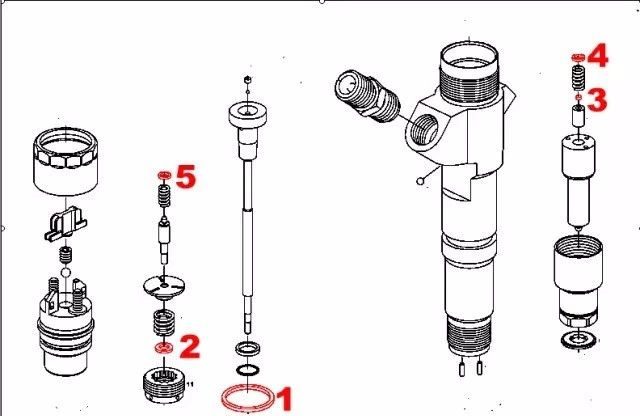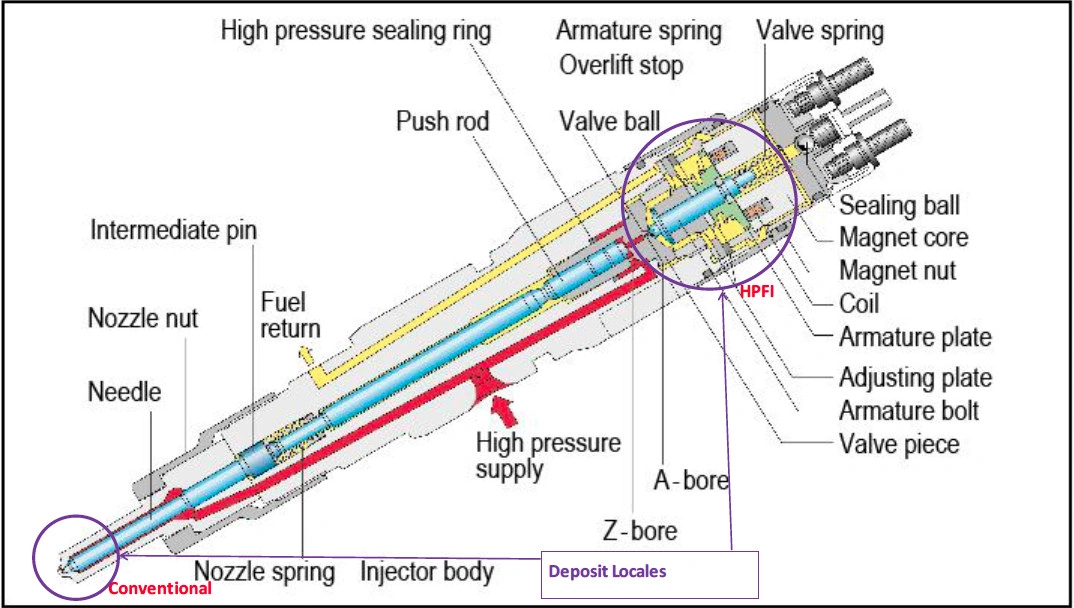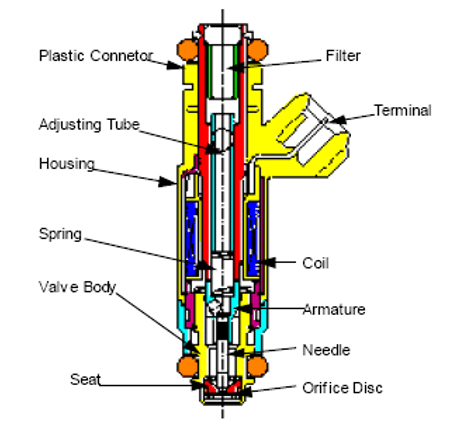Common causes of fuel injector failures and their prevention and elimination methods

The injector is one of the vulnerable parts of diesel engines. It is easy to malfunction when working under high temperature and high pressure for a long time. The causes of several common faults of the injector are analyzed, and prevention and elimination methods are proposed.
The injector is one of the important components of the diesel engine fuel system. It has three main functions: first, to spray and atomize the high-pressure fuel; second, to form a spray beam with a certain injection angle and penetration ability according to the form of the combustion chamber, and form a good quality combustible mixture with the fresh air in the combustion chamber; third, the injection must also comply with certain fuel supply rules, and the fuel supply must start at the right time, stop the fuel decisively, and no dripping occurs. The injector can be divided into two categories, namely open and closed injectors. Closed injectors are widely used in diesel engines. The needle valve pair in the injector is extremely precise in matching. It is easy to malfunction when working under high temperature and high pressure. Some injectors have a very short service life, ranging from one year to several months, or even scrapped in three or five days. Users and maintainers should know the causes of their failures and pay attention to prevention. 1 Injector needle valve stuck
When the needle valve is stuck, the injector cannot work and the single-cylinder diesel engine shuts down.
1.1 Causes of the fault
(1) Poor heat dissipation of the injector. The injector extends into the combustion chamber of the cylinder, and the fuel combustion temperature in the combustion chamber reaches about 2000℃. If the injector cannot dissipate the heat well, the injector will overheat, causing the needle valve pair to get stuck. The main reasons for poor heat dissipation of the injector are: the copper gasket installed on the injector does not meet the requirements, such as the gasket is not clean, asbestos rope or waste cylinder gasket is used instead of copper gasket, which affects heat dissipation; the fuel supply time is not adjusted accurately, resulting in a long afterburning period of fuel combustion, causing the injector to overheat and get stuck; the needle valve sealing cone surface is damaged, and the combustible gas in the cylinder enters the guide surface to form carbon deposits and get stuck. (2) Diesel is not clean, water or acidic substances cause the needle valve to rust; the machine is parked for a long time, corroded by water or water vapor, or parked in the open air or humid places for a long time, causing the needle valve to rust.
(3) Disassembly and assembly damage, improper cleaning or incorrect installation, etc., resulting in the needle valve being stuck.
(4) When installing a new injector, the anti-rust oil is not removed, and the anti-rust oil melts at high temperature and sticks to the needle valve.
1.2 Preventive measures
(1) Select qualified injectors and do not use substitutes. The copper gasket of the injector must meet the technical requirements and remove carbon deposits. It is forbidden to use asbestos rope or waste cylinder gasket as a substitute.
(2) The fuel supply advance angle, valve timing and injection pressure must meet the technical requirements.
(3) When disassembling and assembling the injector, the needle valve pair must not be touched and mixed installation is not allowed. When installing the injector assembly, pay attention to cleaning the injector mounting seat hole. Do not add too many copper gaskets, otherwise it will change the injection distance of the injector, resulting in incomplete combustion, overheating, carbon deposits and seizure of the injector; do not use asbestos rope or other materials instead of copper gaskets, otherwise it will affect the heat dissipation of the injector. When installing the injector fixing bolts, the torque should meet the requirements and be tightened evenly in 3 to 4 times. (4) When the locomotive is parked for a long time, remove the injector assembly from the engine, plug the installation hole with a wooden plug, and place it in clean engine oil. (5) The newly replaced injector must be boiled in clean diesel at 60-80℃ for 10 minutes to remove the anti-rust oil on it. 2 Injector carbon deposition blockage When the injector nozzle is half blocked by carbon deposition, the injector fuel injection volume decreases, the return oil volume increases, and the diesel engine is unable to work. When the injector nozzle is completely blocked by carbon deposition, the fault phenomenon of the diesel engine is the same as the fault phenomenon of the injector needle valve being stuck, that is, the injector does not spray fuel and does not work.

2.1 Cause of failure
The main reason for the carbon deposit blockage of the fuel injector is that the diesel and engine oil are not completely burned in the cylinder, and the carbon deposits are formed by combining with the dust that is not filtered by the air intake. The carbon deposits are bonded to the valves, pistons, cylinder liners, exhaust pipes and fuel injectors in the combustion chamber.
2.2 Preventive measures
(1) Ensure that there is sufficient fresh air in the diesel engine cylinder and the exhaust gas is discharged cleanly. (2) Keep the fuel injector in good technical condition. The injection pressure should be within the specified range, the atomization should be good, and there should be no dripping or leakage of oil. (3) Keep the locomotive in normal technical condition and prevent the occurrence of oil burning. (4) When operating the tractor, the starting throttle should be controlled correctly. The diesel engine should not be started forcibly during starting. The diesel engine should not be started repeatedly, so that too much fuel is injected into the cylinder, resulting in difficulty in starting, and causing too much carbon deposits in the cylinder.

3 Needle valve lift increase
The increase in the needle valve lift of the injector reduces the engine power and increases the fuel consumption. Some exhaust smoke. When the injector is disassembled for inspection, it will be found that the sealing surface of the injector body is dented after being hit by the needle valve shoulder.
3.1 Cause of the fault
When the diesel engine is working, the injector injects fuel several times in a cycle. After long-term impact, the hard injector body sealing surface and the needle valve tail shoulder are worn and sunk, thereby increasing the needle valve lift.
3.2 Troubleshooting method
(1) The injector body sealing surface can be ground with chromium oxide or aluminum oxide on a glass plate. When grinding, the hand must be flat and the force must be even until it is ground flat. This sealing surface must not leak oil during the test. (2) Replace the injector body.
4 High-pressure oil pipe return air
When the diesel engine is running, a cylinder does not work properly and the sound it makes is also abnormal. When using the “cylinder disconnection method” for diagnosis, after loosening the high-pressure oil pipe of the cylinder, it can be found that gas is coming out of the high-pressure oil pipe.
4.1 Cause of the fault
(1) The upper end face of the needle valve seat body and the contact surface of the injector are not level, and the gas enters the injector body through the gap of the joint surface and then enters the high-pressure oil pipe. (2) The injector needle valve is stuck in the open position. When the diesel engine works in the compression stroke, the high-pressure gas enters the high-pressure oil pipe through the nozzle hole.
4.2 Troubleshooting method
(1) The end face of the injector needle valve seat body can be ground with chromium oxide or aluminum oxide on a glass plate. Hold the needle valve body with your hands and turn it upside down on the glass plate to grind until it is flat. (2) After disassembling the needle valve according to the disassembly method of the stuck needle valve, apply a little clean engine oil on the needle valve and put it into the needle valve body for grinding.
